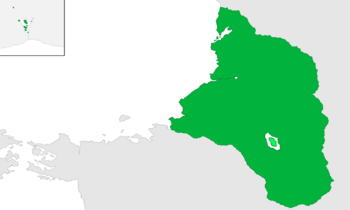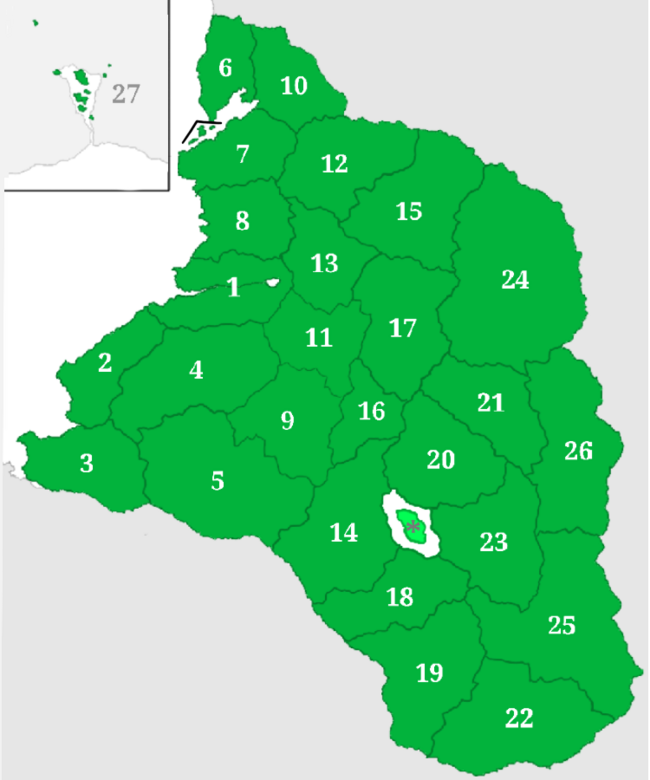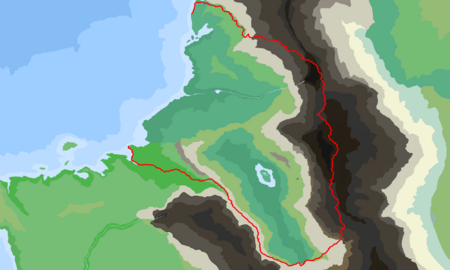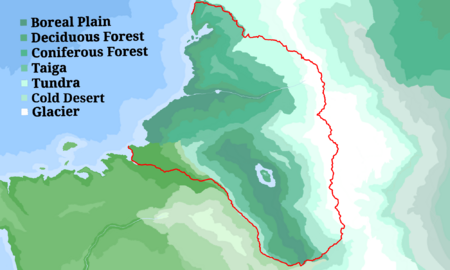Khijovia
This article is incomplete because it is pending further input from participants, or it is a work-in-progress by one author. Please comment on this article's talk page to share your input, comments and questions. Note: To contribute to this article, you may need to seek help from the author(s) of this page. |
Ascended Kingdom of Khijovia Khıjœvïænne Æšcaeē Raēgə | |
|---|---|
Motto: "Vīəra unīəva Laexxe seþþ' Mætriannə jmørre" "Love of the Motherland is our only Law" | |
 Lands and surroundings of the Ascended Kingdom of Khijovia | |
| Capital | Kleitore |
| Largest | Xoviah |
| Official languages | Khijovian |
| Recognised regional languages | Teutorian, Aldorian, Klettorian |
| Ethnic groups | Humans (100%) |
| Religion | Aravianism |
| Demonym(s) | Khijovian |
| Government | Feudalistic Constitutional Monarchy |
• Ascended King of Khijovia | Arcadion II |
• Ascended Queen of Khijovia | Carevia I |
| Legislature | Royal Parliament |
| Area | |
• Land Area | 385,270 km2 (148,750 sq mi) |
| Population | |
• 1611 AR estimate | ~34,275,100 |
| GDP (nominal) | estimate |
• Per capita | 41,850 Shonnenors (46,220 USD) |
| Currency | Shonnenor (SHN) |
| Date format | dd/mm/yy |
| Driving side | right |
Khijovia (Khijovian: Khıjœvïæ [kɪjəʊviə]), officially The Ascended Kingdom of Khijovia, is a feudalistic constitutional monarchy located in northwestern Pelia (in a geographical region usually known as the High West) with Kleitore as its capital city. The nation has a population of about 34 million inhabitants and occupies the entire historical region of the same name, also possessing the Recondian Arcipelago. Delimited to the east by the Clastoclite mountain range, Khijovia is bordered to the north by the Kyldigardian Confederation and to the south by Prestore, and faces the Kesper Sea to the west. The Ascended Kingdom was founded in 1611 AR by Arcadion II shortly after the collapse of the Khijovian Federation and after the return of the Zenonian Dynasty. The State is divided according to the Jovianic Feudal System into 27 administrative regions corresponding to the territorial units of the main Khijovian aristocratic houses plus one special administrative region. A strongly spiritual society, Khijovia has always had a very special relationship with the magical arts.
Etymology
The etymology of the name Khijovia has always been the subject of reconstructions not only by linguists, but also by historians, traditionally attentive to the question; not always, however, we are faced with etymologies in the strict sense, rather with hypotheses which over time have formed a rich corpus of possible solutions, among which there are numerous that refer to popular traditions (such as the mythical existence of an ancient pre-Restart king named Khjvonnə).
It is thought that the name derives from the word Khyjvīə, an exoethnonym with which the Coritians designated a tribe that inhabited the bordering region of Aldoria. It is also hypothesized, however not in contrast with what has been said, that this people worshiped the simulacrum of a pagan divinity, Khœvă. According to this hypothesis, the name would therefore mean "inhabitants of the land of Khœvă".
A further hypothesis instead maintains that the origin of the name is simply the semantic union of the word Khvīəyutœnnə, a qualifying adjective of uncertain etymology which referred to the Holy Kveutonic Empire, with the term Jyœvïæhnnə, which referred to the Jovianic Order and its doctrine.
History
Despite all that prior to the Great Shuffle is basically unknown to the Sparkalian historians, the great cultural and historical heritage of Khijovia has managed to come down to us almost in its entirety thanks to the numerous archaeological sites, written finds and surviving traditions, thus allowing us to faithfully reconstruct the history of the Khijovian region.
A crossroads of numerous neolithic cultures, ancient Khijovia saw the birth and flourishing of a multitude of independent city-states that thrived for hundreds of years during the Era of Ruin, eagerly preserving their culture and language from outside meddling and influences. Following the collapse of the city-state system around 277 BR, the Khijovian territory was occupied by numerous nomadic peoples coming from the North, thus initiating the so-called Barren Age and ending the Archaic Age of Khijovian history. Being purely isolationists, the Khijovians were not concerned with the chaos and turmoil that was tearing apart the rest of Sparkalia, therefore they were not too much affected by wars and famines and continued to live peacefully. As the Great Shuffle occurred, Khijovia was struck with continental amnesia but her culture would manage to survive and persist into time to come.
Khijovia was then conquered without resistence and divided into multiple governatorates by the Kveutonic civilization in 87 AR, becoming one of the most important economic and cultural centers of the Holy Kveutonic Empire. Having reached its maximum expansion in the "heydays" (800-825 AR), the Kveutonic empire then dissolved in 902 due to the continuous invasions of barbarian peoples from the east, thus creating new independent statelets throughout the High West and sanctioning the birth of ancient religious-monastic military orders: among these was the Jovianic Order, which operated on the Khijovian region for more than a century until its disappearance around 1056.
Starting from 1152, the Grand Duke of Klettoria Zenon the Great launched a campaign of national unification and managed to defeat the rival House of Arenia for hegemony over Khijovia, then reuniting the agglomeration of territories into a single Kingdom on July 11, 1161: the Kingdom of Khijovia. Although hundreds of years of reign, on January 28, 1534 the Zenonian Dynasty was driven out in a coup d'état and the Khijovian Federation was founded. However, Federalist Khijovia had a short life as, with the return of the Zenonian Dynasty in 1610, the young prince Arcadion II managed to obtain power and bring the monarchy back to the country: on July 3, 1611 the Ascended Kingdom of Khijovia was founded.
Archaios Aeon
The first settlement of the Khijovian territory dates back to about 70,000 years ago by the Acreatics, a nomadic people whose only remaining archaeological site is preserved in Yvernia on the Pletorian coasts. The Neolithic revolution did not excessively change the lifestyle of the Acreatics, who continued to base their subsistence on hunting and collecting shellfish.
Starting from the sixth millennium AR, however, this population settled in the surrounding regions and, due to the mountainous nature of the territories, transhumant farming developed while agriculture appeared later. The beginning of metallurgy in Khijovia gave birth to the cultures of the Copper Age: the Venatorian culture was born in the north, the Khantan culture in the center and the Coritian culture in the central-south. The Bronze Age led to the development of the Xomian culture on the Axiomia island. while the Iron Age gave birth to the Kleitite culture on the Thevre river. The first forms of politically independent Khijovian city-states began to form as early as the late Bronze Age.
Era of Ruin
Archaic Age
Barren Age
Nova Antiquity and Medieval Era
Kveutonic Age
Jovianic Domination
Modern Era
Surgence Epoch
Zenonian Age
Contemporary Age
Federalist Parenthesis
Ascension Period
Geography
Physical Geography
Geology
Volcanism
Seismic Activity
Hydrography
Climate
Ecosystem
Biomes
Flora
Fauna
Politics
Administrative Regions
| Region | Map of the Khijovian Administrative Regions | |
|---|---|---|
| 1 | Klettoria | 
|
| 2 | Luriah | |
| 3 | Pyrisia | |
| 4 | Qaylasiah | |
| 5 | Atredia | |
| 6 | Chondia | |
| 7 | Charonthia | |
| 8 | Androvia | |
| 9 | Ketheria | |
| 10 | Iverniah | |
| 11 | Kharpovia | |
| 12 | Venatoria | |
| 13 | Profania | |
| 14 | Coritia | |
| 15 | Bellatoria | |
| 16 | Cassiopia | |
| 17 | Corkoviah | |
| 18 | Aldoria | |
| 19 | Teutoria | |
| 20 | Garganthia | |
| 21 | Krakoviah | |
| 22 | Carcassonia | |
| 23 | Sopholenia | |
| 24 | Karkarovia | |
| 25 | Kenveciah | |
| 26 | Akrocanthia | |
| 27 | Recondia | |
| * | Axiomia | |



